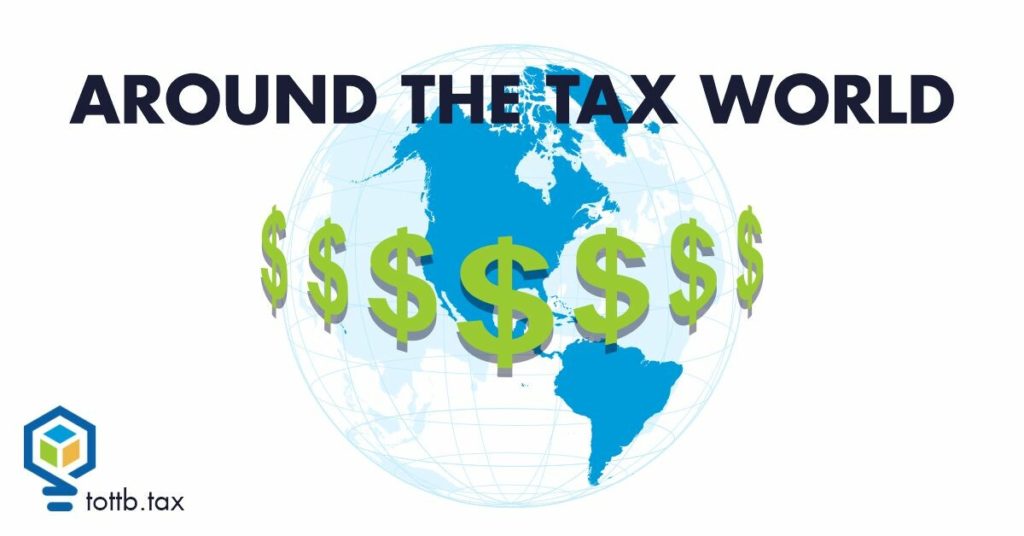
Check out what’s happening all around the world of tax!
Twice per month, we post our “Around the Tax World” feature. This highly curated, concisely written feature acts as your own personal aggregator of all the news happening in and around the world of tax. Your days of endless scrolling and combing the internet for the tax stories of the day ends now because we’re doing that work for you!
Around the Tax World is just one small feature included in a Think Outside the Tax Box subscription. Subscribe today and start enjoying our hundreds of exclusive articles, live webinars, Client Alerts, private Facebook page, and more!
World NEWS
Walmart paid almost $1 billion in taxes after moving PhonePe headquarters to India…
from its previous base in Singapore. Walmart has owned the digital payments company since 2018 when the retailer purchased a majority share of the Indian e-commerce company Flipkart, the previous owner of PhonePe. Moving the company base triggered a massive capital gains tax as investors shifted from the Singaporean to the Indian entity. PhonePe was valued at $5.5 billion in December 2020.
Oil and gas giant Shell is expected to pay $2 billion toward new taxes levied in the U.K.
and European Union. The E.U. voted in September to introduce a “solidarity contribution” that
taxes any surplus profits made by oil and gas companies in 2022 or 2023. The U.K. similarly
introduced its Energy Profits Levy last year, which currently amounts to a 35% windfall tax for
the energy industry. Energy companies have seen tremendous growth in revenue since the
recent embargo on Russian oil products.
U.S. NEWS
38 U.S. states will see tax changes in 2023—including significant tax reductions
Most of this year’s state-level adjustments involve tax cuts, from lower income tax to increased sales tax exemptions. After a nationwide wave of record-breaking tax revenue, many states have funneled part of their surplus back to taxpayers whether that’s through one-time tax rebates and holidays or permanent tax reductions.
In 2023, ten states will see reduced individual income taxes: Arizona, Idaho, Indiana, Iowa, Kentucky, Mississippi, Missouri, Nebraska, New York, and North Carolina. Arizona, Idaho, and Mississippi also shifted to a flat state tax. Additionally, New Hampshire has lowered its taxes on interest and dividends income only. Four states also reduced their corporate income tax rates: Arkansas, Nebraska, New Hampshire, and Pennsylvania.
Another five states chose to make some or all of residents’ retirement income or military pension income tax-exempt: Alabama, Delaware, Iowa, Nebraska, and Rhode Island. Iowa and Nebraska also lessened their inheritance taxes. Meanwhile, other states made adjustments to their sales taxes: Virginia eliminated its grocery sales tax, Kansas has begun to phase out its grocery sales tax, and Colorado, Iowa, and Virginia have exempted new personal hygiene items from sales tax, including menstrual products.
However, not all 2023 tax changes are reductions. Five states have increased taxes on gas, largely due to inflation: Florida, Illinois, Michigan, North Carolina, and Utah. New Jersey also increased its excise tax on recreational marijuana. Kentucky has increased its list of services subject to a 6% sales tax, which will now include clothing and jewelry repair, cosmetic surgery and body modification, interior decorating, parking, personal fitness, recreational camp tuition, rental space, security system monitoring, and website design and hosting. The state also introduced a 6% excise tax on ride-sharing, car rental, limousine and taxi services, and electric vehicle power distribution.
Becoming the seventh state to add a “millionaire tax,” Massachusetts approved a 4% surtax for residents earning above $1 million with the funds going toward education, infrastructure, and public transit.
STATE NEWS
Kentucky legislators seek to pass an income tax reduction bill… that would lower the rate to 4% in January 2024. This comes on the heels of a recent tax cut as the state’s income tax dropped from 5% to 4.5% on January 1, 2023.
Opponents of the bill have expressed concern that the loss of revenue would negatively impact Kentucky’s poorest families and limit state-provided services, such as education and public safety. Additionally, they have pointed to one-time boosts like pandemic aid from the federal government and warned that future revenue streams may be much lower.
Proponents of the bill point to positive economic trends and continue to advocate for their overall goal to phase out Kentucky’s individual income tax entirely. They have also noted that the current tax bill includes fiscal conditions that must be met before the tax rate can be lowered. Additionally, in 2022, the state extended its sales tax to include more services to compensate for the loss of income tax revenue.
Wisconsin residents will see the state’s all-time lowest tax burden… largely due to recent income tax cuts. The tax burden is measured by comparing total taxes collected with total personal income within a state—this number has been recorded for the state of Wisconsin since 1970.
In 2022, Wisconsin passed a measure to lower its third income tax bracket from 6.27% to 5.3%. This income tax cut lowered revenue by 0.7%, and yet state and local tax collections still increased last year, up from $33.9 billion to $35.3 billion. Meanwhile, in 2021, workers saw an average 6.7% growth in their personal income, which likely accounts for the lower tax burden.
Tax revenue in Wisconsin has been steadily increasing year-over-year since at least 2014. As a result of increased collections and limited spending, the state now holds a record-breaking $6.6 billion surplus. This increased revenue is due in part to higher sales tax and gas tax collections. As inflation has risen, so has total consumer spending on goods and services.
TAX PLANNING
New year, new tax brackets—taxpayers anticipate higher take-home pay in 2023. Each year federal income tax brackets and standard deductions are adjusted for inflation, which means that taxpayers may finally see a benefit from the recent increases in the cost of living. In October 2022, the IRS announced that higher limits would be set to avoid bracket creep—where taxpayers are shifted into higher income brackets even though their purchasing power has not increased.
For both single and married taxpayers, tax brackets will be raised by about 7% in 2023:
Single Filers:
- 10% for income up to $11,000
- 12% for income over $11,000
- 22% for income over $44,725
- 24% for income over $95,375
- 32% for income over $182,100
- 35% for income over $231,250
- 37% for income over $578,125
Joint Filers:
- 10% for income up to $22,000
- 12% for income over $22,000
- 22% for income over $89,450
- 24% for income over $190,750
- 32% for income over $364,200
- 35% for income over $462,500
- 37% for income over $693,750
Additionally, the standard deduction has been increased to:
- $13,850 for single taxpayers and married individuals filing separately
- $20,800 for heads of households
- $27,700 for married couples filing jointly
The IRS has also increased the earned income tax credit to a maximum of $7,430 and raised the maximum contribution for health FSAs to $3,050.
Trump’s tax records spark discussion about whether the rich should claim Social Security benefits. The recent release revealed that the former President had not claimed Social Security benefits from 2015 through 2020. This discovery brings up the question of whether high-income earners should claim the benefits they are eligible for, given the program’s funding challenges. Social Security is currently experiencing a shortfall that will ultimately result in a decrease in benefits—only 80% will be covered by the year 2035 if no changes are made.
In 2022, about $1 trillion in benefits was claimed by about 70 million retired or disabled Americans. To receive payments, workers must earn 40 “credits” by paying Social Security taxes and must be aged 62 or older. Higher benefits are available for those who continue to work after retirement age or who claim benefits at their full retirement age (generally age 66 or 67). In 2023, the maximum monthly payout is $3,627.
Financial experts advise soon-to-be retirees to wait until age 70 to claim Social Security since this will result in the largest paycheck. For each year after full retirement age that they delay their claim, retirees can receive an 8% increase in benefits. This remains true until age 70, at which point there is no benefit to delaying Social Security.
Recent Highlights
Wondering what you missed in our last newsletter? Check out our latest exclusive articles here:
NOT A MEMBER YET?

SUBSCRIBE TO GET ALL OF OUR
GREAT ARTICLES AND RESOURCES!
CURRENT EDITION

Intentionally Filing a Defective Tax Return
Creativity on a tax return is a natural tendency. Many strategies and behaviors we know are wrong, e.g. not reporting all income. However, is it ever okay to disregard some deductions and pay more tax? At first glance, it would seem that the IRS should like the idea of more reported income and a higher tax liability attached to the additional income. The IRS does not.

Side Hustles and Tax Tussles: Tax in the Gig and Share Economy Part Two
The gig economy involves more than one-off and part-time jobs. It also includes when you share your property in exchange for money. This can be a residential property, a vacation home, or even a vehicle. The gig economy has connected those who need rides and places to stay with owners via online platforms. We refer to this part of the gig economy as the share economy.
Accessing these accommodations is easy with the online platforms. But how the people participating should report their income isn’t quite as straightforward. Last time we looked at how your clients should report gig income, just like any other income made as a sole proprietor.
But making money from renting your property out is different, right? If you have clients with rental properties, you report their income on Schedule E (1040), Supplemental Income and Loss. We know from last time that we report gig economy income on Schedule C (1040), Profit or Loss from Business. So, how does rental income derived from the share economy get reported on a tax return? Every taxpayer’s favorite answer, it depends.

Loose Change in Your Couch and Maybe a Tax Break at Your Kitchen Table
A 2023 Tax Court decision upheld what many small business owners and tax practitioners have wondered about for some time. The court found that shareholders of an S corporation could exclude rental income paid to them by their S corporation for holding planning meetings in their homes. While the IRS and court found that the amounts charged by the shareholders were excessive, the court found the arrangement itself within the bounds of the law.
This article examines this case and underlying law and when and how this is a planning idea worth pursuing, the limitations and unknowns involved, and the policy implications of this long standing exclusion. The case is Sinopoli, TC Memo 2023-105 involving the exclusion at IRC Section 280A(g).
